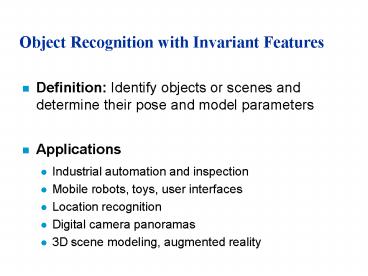Object Recognition with Invariant Features - PowerPoint PPT Presentation
Title:
Object Recognition with Invariant Features
Description:
Object Recognition with Invariant Features Definition: Identify objects or scenes and determine their pose and model parameters Applications Industrial automation and ... – PowerPoint PPT presentation
Number of Views:95
Avg rating:3.0/5.0
Title: Object Recognition with Invariant Features
1
Object Recognition with Invariant Features
- Definition Identify objects or scenes and
determine their pose and model parameters - Applications
- Industrial automation and inspection
- Mobile robots, toys, user interfaces
- Location recognition
- Digital camera panoramas
- 3D scene modeling, augmented reality
2
Cordelia Schmid Roger Mohr (97)
- Apply Harris corner detector
- Use rotational invariants at corner points
- However, not scale invariant. Sensitive to
viewpoint and illumination change.
3
Invariant Local Features
- Image content is transformed into local feature
coordinates that are invariant to translation,
rotation, scale, and other imaging parameters
SIFT Features
4
Advantages of invariant local features
- Locality features are local, so robust to
occlusion and clutter (no prior segmentation) - Distinctiveness individual features can be
matched to a large database of objects - Quantity many features can be generated for even
small objects - Efficiency close to real-time performance
- Extensibility can easily be extended to wide
range of differing feature types, with each
adding robustness
5
Build Scale-Space Pyramid
- All scales must be examined to identify
scale-invariant features - An efficient function is to compute the
Difference of Gaussian (DOG) pyramid (Burt
Adelson, 1983)
6
Scale space processed one octave at a time
7
Key point localization
- Detect maxima and minima of difference-of-Gaussian
in scale space
8
Select canonical orientation
- Create histogram of local gradient directions
computed at selected scale - Assign canonical orientation at peak of smoothed
histogram - Each key specifies stable 2D coordinates (x, y,
scale, orientation)
9
Example of keypoint detection
Threshold on value at DOG peak and on ratio of
principle curvatures (Harris approach)
- (a) 233x189 image
- (b) 832 DOG extrema
- (c) 729 left after peak
- value threshold
- (d) 536 left after testing
- ratio of principle
- curvatures
10
SIFT vector formation
- Thresholded image gradients are sampled over
16x16 array of locations in scale space - Create array of orientation histograms
- 8 orientations x 4x4 histogram array 128
dimensions
11
Nearest-neighbor matching to feature database
- Hypotheses are generated by approximate nearest
neighbor matching of each feature to vectors in
the database - We use best-bin-first (Beis Lowe, 97)
modification to k-d tree algorithm - Use heap data structure to identify bins in order
by their distance from query point - Result Can give speedup by factor of 1000 while
finding nearest neighbor (of interest) 95 of the
time
12
Detecting 0.1 inliers among 99.9 outliers
- We need to recognize clusters of just 3
consistent features among 3000 feature match
hypotheses - LMS or RANSAC would be hopeless!
- Generalized Hough transform
- Vote for each potential match according to model
ID and pose - Insert into multiple bins to allow for error in
similarity approximation - Check collisions
13
Probability of correct match
- Compare distance of nearest neighbor to second
nearest neighbor (from different object) - Threshold of 0.8 provides excellent separation
14
Model verification
- Examine all clusters with at least 3 features
- Perform least-squares affine fit to model.
- Discard outliers and perform top-down check for
additional features. - Evaluate probability that match is correct
- Use Bayesian model, with probability that
features would arise by chance if object was not
present (Lowe, CVPR 01)
15
Solution for affine parameters
- Affine transform of x,y to u,v
- Rewrite to solve for transform parameters
16
3D Object Recognition
- Extract outlines with background subtraction
17
3D Object Recognition
- Only 3 keys are needed for recognition, so extra
keys provide robustness - Affine model is no longer as accurate
18
Recognition under occlusion
19
Test of illumination invariance
- Same image under differing illumination
273 keys verified in final match
20
Location recognition
21
Show PhotoTourism video
22
- Sony Aibo
- (Evolution Robotics)
- SIFT usage
- Recognize
- charging
- station
- Communicate
- with visual
- cards































